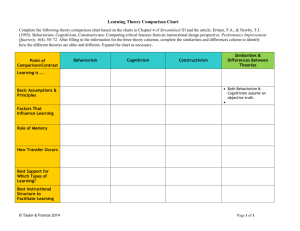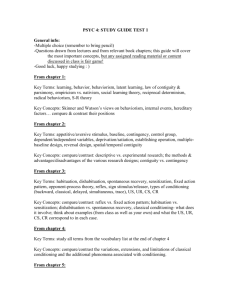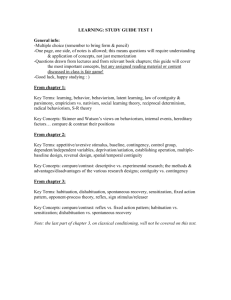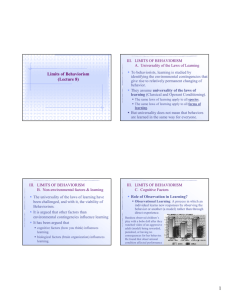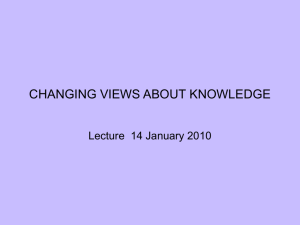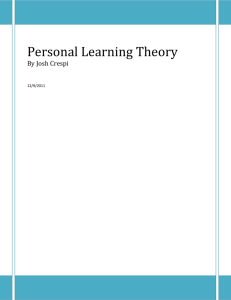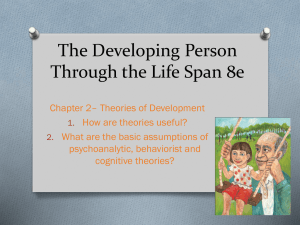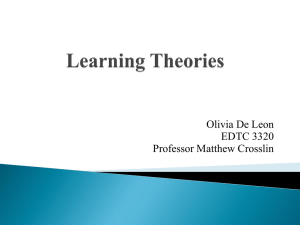Day 2 Behaviorism - CI512
advertisement
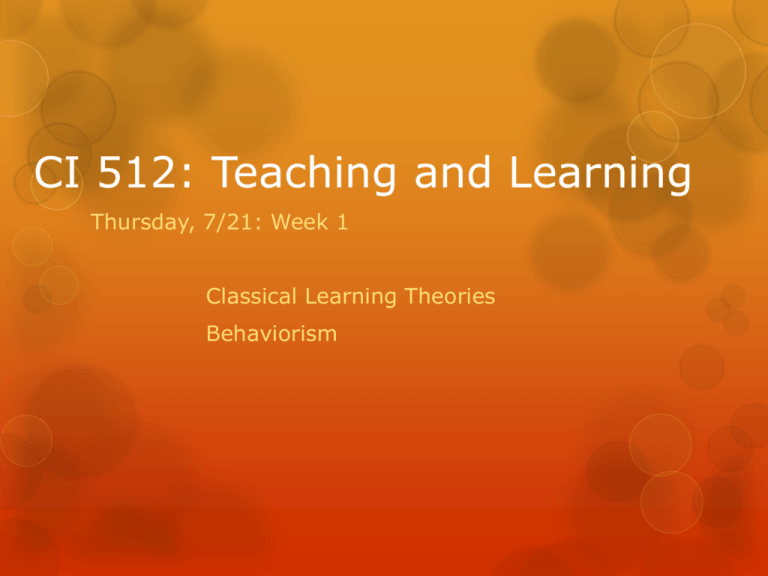
CI 512: Teaching and Learning Thursday, 7/21: Week 1 Classical Learning Theories Behaviorism Class Outline – Classical Theories and Behaviorism Note Taker: Iman Alattar Observer: Martin Rausch Community Standards and Logistics (9:00-9:05) Syllabus Questions and Outline of the Course (9:05-9:20) Classical Learning Theories (9:20-9:40) Behaviorism, Drill & Practice Small Group Discussion and Break (9:40-10:30) Whole Class (10:30-11:00) Snapshots Work-time (11:00-11:35) Observer Observations (11:35-11:40) Conclusions and Exit Cards (11:40-11:50) Scoring Guide for Synthesis Paper Summarizes at least three theories of teaching and learning Articulates an educational philosophy that includes at least one theory of teaching and learning Applies age-appropriate application of teaching and learning theory within a cultural and community context Uses knowledge of teaching and learning theories to depict respectful, supportive and challenging learning environments No Evidence Some Evidence Substantial Evidence No Evidence Some Evidence Substantial Evidence No Evidence Some Evidence Substantial Evidence No Evidence Some Evidence Substantial Evidence Community Standards Goals Practices - Respectful Interaction - Inclusion of Diverse Perspectives - Active Participation - Allow time for reflection - Distinguish facts from opinions in discussion - Use moderation judiciously to balance between free-flowing conversation and domination - Come to class prepared - Be respectful Comments from Exit Cards Many are aware of their role as a listener and a speaker in the class Learning names Community practice of stating your name before you talk Changing Seats Lingering Questions about Course Content Tentative Calendar 7/19 Introductions, Course Expectations, Theory 7/21 Work on Snapshots Classical Learning Theory Behaviorism 7/26 Snapshot Draft 1 Procedural vs. Conceptual Understanding 7/28 Work on Snapshots Learning and Transfer Dewey and Realistic Education 8/2 Snapshot Draft 2 Constructivism I 8/4 Constructivism II Group work brainstorm- evaluation criteria 8/9 Synthesis Draft Due Response Due Social Learning Theory Work on Presentations 8/11 Snapshots Due Response Due Reactions to constructivism Work on Presentations 8/16 Presentation Paper Due Presentations 8/18 Synthesis Paper Due Presentations and Wrap-up Classical Learning Theories Plato Lock Freud Plato (428?-347 BC) All knowledge rests in an eternal soul, but is forgotten upon birth Er visited the Lethe river in Hades and witnessed souls drinking forgetfulness Knowledge construction is the process of remembering what was forgotten Allegory of the Cave How is learning symbolized in this allegory? How does teaching take place? Plato “Learning” is a passive process Instruction should be teacher centered- those with greater wisdom can be a guide for the ignorant Emphasis on the importance of learning virtues and reason “We must reject the conception of education professed by those who say that they can put into the mind knowledge that was not there before– rather as if they could put sight into blind eyes… The faculty by which he learns is like an eye which cannot be turned from darkness to light unless the whole body is turned; in the same way the mind as a whole must be turned away from the world of change until it can bear to look straight at reality.” - Plato, The Republic John Locke (1632-1704) “Tabula rasa” (blank slate) philosophy maintains that human minds are born completely free of content The mind is biologically wired with abilities such as memory, recall, and the capacity to join ideas together Simple ideas are formed directly through experience and observation Simple ideas can be combined to form complex ideas. A study by Rothstein (2008) found the following “On average, professional parents spoke more than 2,000 words per hour to their children, workingclass parents spoke about 1,300, and welfare mothers spoke about 600. At 4 years old, children of professionals had vocabularies that were nearly 50 percent larger than those of working-class children and twice as large as those of welfare children.” How could this be explained through Lockean educational theory? Sigmund Freud (1856-1939) Learning is controlled by our psyche Learning is a challenging processes in which a child’s “natural state” is changed Constant conflict between the ego and natural desires The child is frightfully inconsiderate of others and egotistic; he is only concerned with getting his own way and satis-fying his own desires; he is quite indifferent as to whether this hurts others or not. He is dirty and odoriferous; he does not mind catching hold of the most disgusting things or even putting them to his mouth. He is quite shameless so far as his own body is concerned and very curious about the things that other people wish to conceal from him. He is greedy and will steal dainties. He is cruel to all living creatures that are weaker than himself and filled with a perfect lust for destroying inanimate objects. He has an abundance of naughty bodily tricks, he sucks his fingers, he bites his nails, he picks his nose and plays with his sexual organs; he does all these things urged by his intense desire for self-fulfillment, and regards the slightest hindrance as intolerable. -Anna Freud (1935) Small Group Discussion 1. Phillips and Soltis (Behaviorism) What are the primary features of behaviorism? How to the tenants of behaviorism align with current standardized testing practices? 2. Resnick and Ford (Drill and practice) For what types of learning has drill and practice been particularly effective for you? For what types of learning has it been ineffective? 3. Brownell (Reaction to drill and practice) Behaviorism Lens for research Theory on what consists of learning Focuses on external behaviors of humans Views human learning as biologically similar to animal learning Behaviorism Classical Conditioning Pavlov (1849-1946) Focuses on involuntary response mechanisms for learning Operant Conditioning Thorndike (1874-1949) Reinforcement (positive and negative) to reinforce bonds Skinner (1904-1990) Continuous vs. intermittent reinforcement schedules Drill & Practice and the role of automaticity Working memory space is limited Automaticity frees up space in working memory to allow for other cognitive function Common examples include talking while driving, reading, and arithmetic Working Memory Theory Miller (1957) The Magical Number Seven, Plus or Minus Two: Some Limits on Our Capacity for Processing Information Barn Engine Bay Fire Ticket Key Swallow Hair Green Cabin Duck Anger Place Gun Data Land Hard Feet Spoon Loud Heart Working Memory Theory Miller (1957) The Magical Number Seven, Plus or Minus Two: Some Limits on Our Capacity for Processing Information Differentiation of Inputs of a single characteristic (loudness, pitch, taste, shades of grey) (7±2) Memorization of “bits” of information (7±2) “Bits” could be recoded into “chunks” Recoding Binary Data into Chunks Barn Engine Bay Fire Ticket Key Swallow Hair Green Cabin Duck Anger Place Gun Data Land Hard Feet Spoon Loud Heart Working Memory and Recoding Sidney Smith (1954) was able to recode at a 5:1 ratio and recite a 40 digit binary number to the Eastern Psychological Asociation Snapshots Group Activity Think of a personally significant learning experience How might you explain or interpret this experience through the lens of behaviorism? Snapshot Draft (due Tuesday 7/26) Carefully describe one learning experience in a well written paragraph Interpret this experience through the lens of behaviorism Snapshots Groups Group 1 Group 2 Group 3 Group 4 Group 5 Group 6 Iman Derek Colin Teale Greg Mike T. Carlos Arielle Westie Chad Michael Nick Mike P. Chai Karen Sean Kyle Laura Casey Mike M. Martin Exit Cards Rate your level of participation for today (0-3) What went well for you in class? What could be improved for you in class?

